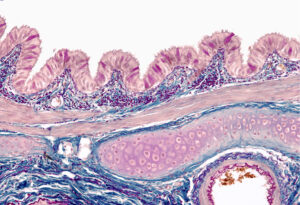Answering the question you want to ask – Dr Pleasantine Mill discusses her group’s work on cilia, centrosomes and ciliopathies.

Dr Pleasantine Mill, an MRC Investigator at the IGMM and winner of the 2019 BSCB Early Career Medal for Women in Cell Biology, discusses her approach to understanding the genetic and molecular processes that underpin cilia biogenesis and cilia-associated human diseases. Her work is funded by the MRC and the ERC.
Born in Canada, Pleasantine graduated with a bachelor’s degree from McGill University in Montréal, and received her PhD from the University of Toronto, studying the Hedgehog signalling in skin development and cancer. Next, Dr. Mill moved to Edinburgh, and joined the Medical Research Council (MRC) Human Genetics Unit (HGU) for her postdoc with Professor Ian Jackson.

Dr Pleasantine Mill
Here, she jumped to forward genetics with a mutagenesis screen in mice, focusing on neural crest development. Speaking about the shift in focus, Dr. Mill told me that “[I wanted] to go to the other side of the neural tube … I wanted to discover new exciting things, unknown biology!” It was this change of research area that brought Dr. Mill to her current work on cilia. Dr. Mill noted that “Without any assumptions about the processes I was screening, six out of the ten mutants I found were in all cilia genes highlighting the importance of cilia.” This discovery and the work that followed led Dr. Mill to establish her own research group within the IGMM in 2014, focusing on the roles of mammalian cilia and how disorders relating to them, collectively named ‘ciliopathies’, lead to disease. Cilia are small hair-like structures that protrude from the surface of the cell, and are involved in many processes within the body. Some cells possess multiple moving cilia on their surface, while other cells only possess a single sensory cilium that can be used in cell signalling or communication.
Biology is a highly complex and frequently messy science. Biochemistry, cell biology, genetics, and developmental biology are labels which seek to compartmentalize complex and often overlapping processes. These are labels that mean little to an organism as a whole, resisting complete compartmentalisation. No molecule or gene is an island in biology. Yet Dr. Mill told me that she enjoyed the potential of conducting research that moved across divisions and scales in biology; “It was lesions in genes through to how they affected signalling and disrupted physiology too, from subcellular architecture in cell biology up to how it altered embryology …the creativity in it, and the ability to look at many different aspects of biology excited me.”
The Mill group’s current focus is on understanding mammalian cilia diversity: “The question arises whether the cilia found in cell lines routinely in the lab can fully capture differences we observe in structural and molecular architecture of cilia affected in tissues of ciliopathy patients? How do we better understand these differences and their differential sensitivity to disease causing mutations?”
When I asked what challenges are involved in her research, Dr. Mill replied: “In order to better understand these biological processes, we need better tools. Therein lies the challenge, the technology involved is very exciting and the possibilities are endless but … it can be a difficult process of trial-and-error to design sensitive biosensors and reporters which work in vivo.” The reward is making findings more translatable to human disease. “Unravelling clinical phenotypes we see in patients or animal models back to the underlying cell biology, needs to happen on an organ or tissue level”, Pleasantine says.

A light microscope image of epithelium cells lined with cilia in the bronchus. (Image from Shutterstock.com)
Understanding cilia biogenesis, their dynamics and the cellular processes they control in different cell types is important understanding and treating cilia diseases. Live cell imaging allows for more quantitative information to be gained about the events unfolding within the cell, and is something the Mill lab is very active in. One example was a joint effort with Dr Richard Mort, now lecturer at Lancaster University, where they developed a fluorescent cilia and cell cycle biosensor. Using a three fluorescent reporter probe in a single construct system, the biosensor can distinguish cilia and stages of the cell cycle in real-time live-imaging in cells and in vivo. Dr Mill notes that with imaging, seeing is believing: “Immunofluorescent imaging is a snap-shot, whereas if you can watch processes happen live and on scale you get so much more information – [we’re] only beginning to scratch the surface of the applications of this technology”. She goes on to say “[We want to see] how these events change over time, between tissues and genotypes by live imaging, we are building new tools to understand the fundamental questions that we have and how they’re disrupted in disease.” In science, if the method doesn’t exist to answer a question, then you have to get creative.
Studying ciliopathies is certainly not an easy task. The umbrella term describes approximately 40 overlapping syndromes thought to be caused by mutations in about 200 different genes. One ciliopathy that Dr. Mill has worked on is primary ciliary dyskinesia (PCD), where cilia where cilia motility is disrupted. This leads to mucus build-up within the lungs and reoccurring respiratory infections throughout the patient’s life. Currently there are no effective treatments or cure for PCD, the majority of treatments focus on managing the symptoms. However, Dr. Mill’s group is hopeful that their work on PCD will further improve the lives of PCD patients in the years to come in terms of disease mechanisms but also with genome surgery. Speaking on her group’s work, Dr. Mill notes that: “[PCD is a] chronic condition where these patients have cycles of infection and inflammation sometimes requiring lung transplants … In the case of airway disease, airways are accessible, decades of work on how to deliver genetic payloads to them so we’ve been asking what if we could correct a patient’s mutation in their lungs and restore airway health as a cure?” To do this, her group is working to build novel genome editing reporters which help to visualize how different cell types in the body resolve DNA breaks on genome editing and how these events can be harnessed for therapeutic benefit. The Mill group has made progress in understanding PCD, identifying new genes implicated in the disease and suggesting new strategies to combat the disease, and hopes to develop an individualized genome surgery approach to cure PCD: “ [there was] never going to be a one hit fix for this [as there are over 50 implicated genes in PCD], this is the ultimate personalised medicine … where patient-informed corrective genome editing could be revolutionary for this rare and neglected disease as well as other ciliopathies.”
Dr. Mill’s group continues to advance understanding of ciliopathies and cilia behaviour, with the current 10+ members of her lab working on disorders ranging from cancer to eye diseases. When asked for advice she would give to new PhD students such as myself, Dr. Mill says: “Be bold. There are no dead ends in science. The process might take a little more time and a little more work, but everything is possible.”



